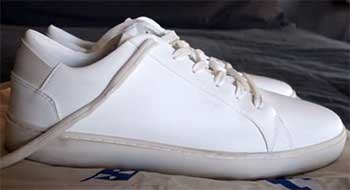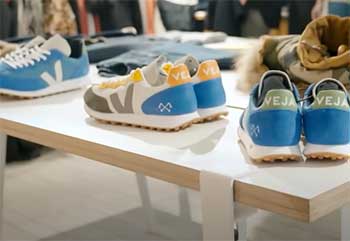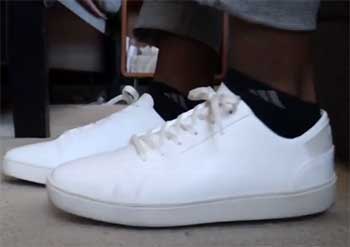Sustainable fashion is on the rise, and shoe brands Thousand Fell and Veja are leading the pack when it comes to eco-friendly sneakers. Both brands use recycled and organic materials to construct their shoes, but they have some key differences that consumers should consider.
This comprehensive guide will compare Veja and Thousand Fell’s shoe features, comfort, style, sustainability practices, and more to help you decide which brand is the better fit.
A Brief Comparison Table
First let’s run through a high level feature comparison assessing important factors shoe buyers reference when making purchasing decisions:
| Feature | Thousand Fell | Veja |
| Sustainability | Uses recycled plastic bottles in shoe materials. Carbon neutral shipping. | Uses organic cotton, recycled plastic bottles, wild rubber. B-Corp certified. |
| Manufacturing Ethics | Fair trade certified factory. Provides living wages and good working conditions. | Fair trade certified. Provides living wages and good working conditions. Does not disclose factory locations. |
| Style Variety | One low top lace up sneaker design offered in 30+ color/print options. | Various styles including low, mid and hightop lace ups, slip on and straps. Lots of colors/prints/materials. |
| Sizing Options | Men’s sizes 7-13 whole sizes only. Women’s sizes 5-11 whole & half sizes. | Unisex sizing covering 5-13 in whole and half increments. |
| Water Resistance | Mesh upper allows water inside. Not waterproof. | Mesh upper allows water inside. Not waterproof. |
| Durability | Lightweight knit fabric prone to holes and tears over time. | Durable rubber soles last through years of wear. |
| Traction | Flat rubber outsoles offer average traction. | Patterned rubber outsoles with better traction. |
| Break-In Period | None needed – lightweight from first wear. | 1-2 weeks for stiff leather/rubber to soften and mold. |
To summarize the table briefly, Thousand Fell has fewer style choices but more sizing options and comes from a carbon neutral supply chain. Veja offers greater variety in looks, colors and materials but runs small in sizing availability. Neither are waterproof or especially durable for outdoor pursuits.
But there’s more nuance worth discussing on comfort, style, sustainability sourcing, transparent manufacturing, and pricing comparisons between the two brands. Let’s explore those topics in more detail.
Comfort and Fit Comparison

Finding the perfect shoe means balancing visual appeal with all day comfort.
How do Veja and Thousand Fell stack up on fit and coziness?
Thousand Fell shoes utilize knit fabric uppers from recycled materials, paired with a lightweight foam midsole for cushioning.
The flexible, foot-hugging upper provides a relaxed fit with decent shock absorption.
Reviewers describe them as comfortable for short term wear, but lacking support features for long durations on your feet. Issues like flat arches and thin outsoles lead to foot soreness over 5+ hours of activity. They also stretch and feel loose over time.
By comparison, Veja sneakers use a mix of organic cotton canvas, recycled plastic bottles mesh, wild rubber, and leather for structure. The stiff materials take 1-2 weeks to properly break-in as they mold perfectly to your feet.
While not as instantly soft as Thousand Fell, Veja designed their shoes for urban adventures. Once worn-in, the snug fit, padded collar, and grippy sole provide excellent shock absorption and traction for hours out and about.
However, buyers warn Veja’s slim silhouette and structured leather leaves no room for orthotics – making them uncomfortable for those needing arch support or with wider feet.
Ultimately, Thousand Fell works nicely for laidback settings but can’t withstand heavy activity without discomfort. Veja better supports lengthy wear IF you have narrowish feet without inserts needs. For pure plushness upfront, go Thousand Fell. For longtimesupport, Veja takes the cake.
Style and Design Showdown
In addition to feel good factor, shoppers want their ethics aligning shoes to look stylish too! Here’s how the brands compare aesthetically:

Veja utilizes heritage sneaker silhouettes like low, mid and high top lace ups, slip ons and strap styles across various materials – think cotton canvas, mesh, suede and leather.
Design details like contrasting textures, neutral color blocking with pops of color, and metallic logos provide visual interest with a timeless casual vibe.
Their shoes blend into both dressy and relaxed outfits seamlessly, fitting France’s signature je ne sais quois style.
Comparatively, Thousand Fell sneakers have a decidedly sporty, casual appearance. Their one low top lace up silhouette comes in both neutral and bright shades, with the chunky sole and prominent side logos looking laidback.
The knit upper resembles workout shoes even in muted colors. Mostly they’ll complete your off-duty, athleisure or loungewear apparel outfits as opposed to dressierLooks, giving off youthful Millennial vibes.
So if you want an everyday sneaker to take you from errands to evening drinks with panache, Veja is the move. Seeking cute kicks strictly for hanging with friends or the gym? Go Thousand Fell.
Both brands design attractive shoes – just for different activities and aesthetics. The variety of Veja collections appeals to wider age ranges and uses too.
Comparing Sustainable Factors: Materials and Manufacturing Ethics
Of course sustainability sits front and center for both labels. But once you scratch beneath the surface at sourcing and process transparency, key distinctions emerge between Veja and Thousand Fell’s approach.
- Veja’s Materials and Supply Chain
For nearly 20 years, pioneering environmental improvements throughout production ranked core to Veja’s principles. As early adopters of sustainable materials in 2004 using wild Amazonian rubber and organic cotton, they helped move the needle industry-wide.
Today Veja utilizes raw materials like 100% recycled PET plastic from bottles, organic cotton, sustainably tapped rubber trees preserving Amazon forests, banana oil polyester (from banana harvest waste!), recycled cardboard for shoe boxes printed with water based inks and more kind-to-Earth fabrics.

By partnering directly at the agricultural level and investing in innovation for alternative materials, Veja transforms source ingredients into coveted shoes.
However, some criticize them for not sharing details publicly on ALL suppliers and factory partners amidst competitiveness concerns.
In line with their transparency mission, Veja gets frequent audits on ethical and ecological standards by independent certifier, the Fair Trade Labelling Organization.
They even publish social and environmental impact reports annually – going far beyond competitors and earning B-Corp certification to prove accountability. This rigorous evaluation by a respected third party provides credibility for Veja’s commitments compared to self-reported claims.
From innovative sustainable materials investments to third party auditing benchmarks, Veja makes measurable impacts minimizing environmental harm.
Sure, they aren’t perfect – shipping from Brazil carries heavy carbon emissions and not every single material or supplier appears on their website. But they actively listen to stakeholder feedback for continuous improvement towards ethical, ecological objectives.
Also Read: Reasons For Golden Goose Shoes Being So Expensive.
- Thousand Fell’s Sourcing Strategy
Alternatively Thousand Fell adopted simpler sourcing and production models to streamline costs passed onto buyers. Their shoes primarily use recycled plastic bottles transformed into knit uppers via trusted industry partners.
Rubber soles plus laces and lining fabrics aim for recycled or sustainably harvested materials too.
By manufacturing in Mexico at one fair trade certified factory owned by parent company Enso Group, Thousand Fell keeps close tabs on worker treatment without reliance on external oversight.
Sourcing knits domestically cuts shipping miles as well resulting in carbon neutral delivery. Thousand Fell even incentivizes customers to recycle their old sneakers to further reduce waste outputs.
However, critics say Thousand Fell’s sustainability initiatives need more regulation through certifications like B-Corp. The company hasn’t released thorough impact reports or materials traceability data either – making their eco-friendly claims difficult to quantify.
While they check boxes on recycled ingredients and ethical factories, greater transparency around where exactly materials come from and final product destination could build trust. External auditing on warehouse electricity usage, worker wages and chemical processing would substantiate Thousand Fell’s promises too.
If having concrete data proving environmentally gentle, socially responsible goods matters in your buying choices, Veja edges out Thousand Fell by securing in depth Fair Trade and B-Corp certification.
But Thousand Fell still demonstrates positive intentions through traceable factory partnerships and domestic material sourcing to reduce shipping impacts. Both make laudable strides – just using different approaches.
The Price Point Showdown: Factors Impacting Affordability
Let’s switch gears to discuss the bottom line – what these conscious kicks will cost you! Veja and Thousand Fell exist on opposite ends of the price spectrum due to business model and supply chain variances:
- Why Veja Shoes Cost More

Ranging from $120 to $280, Veja sneakers cost markedly higher than Thousand Fell’s singular $125 price point.
But that premium nets shoppers sustainably sourced leather and rubber from Brazil, complex production processes by skilled artisans, and ethical working standards across a sprawling supply chain.
By investing in organic, equitable supply chains, Veja incurs higher costs that translate to customer pricing.
And by manufacturing the bulk of shoes in Brazil then exporting worldwide, extra import/export fees and shipping emissions apply too.
Yet their choice to produce abroad means supporting economic growth in developing regions. So you pay for positive environmental AND social change beyond the end product.
Plus quality construction and coveted style renders their shoes valued in the resale market – you’ll recoup much of the initial splurge should you tire of that floral print high top down the road.
Ultimately with Veja, you pay more BUT get premium sustainable materials, reputable brand heritage, competitive worker treatment and classic styling in return.
Also Read: Comparison of Allbirds And Vivaia Shoes.
- Why Thousand Fell Shoes Stay Affordable
Alternatively, Thousand Fell adopted lean, digitally savvy business practices allowing $125 price parity across every style. How’d they pull off lower pricing? Thousand Fell sells exclusively through their own website, avoiding retailer markups.
Their direct-to-consumer model paired with a single American factory for straightforward manufacturing reduces middlemen costs. Thousand Fell also forewent external organic or fair trade certifications that require investments of time and money to obtain.
Does the convenience of buying Thousand Fell online or recognizing their materials weren’t blessed by NGOs mean terrible ethics though?
Not necessarily. Thousand Fell checks sustainability boxes through recycled materials, ethical local production, and carbon neutral practices just certified by different auditing processes.
Yet the lack of robust external review leaves some shoppers questioning if corners got cut elsewhere from a transparency standpoint.
At the end of the day, Thousand Fell Detroit Runners offer affordable, domestically produced eco-kicks using traceable recycled materials and factories. But their simplified business structure skips costly steps prioritizing worker empowerment and environmental welfare elsewhere in Veja’s supply chain model.
Both brands make reasonable trade-offs around pricing, social consciousness and resource use. Buyers simply need to determine if accessible cost or investment in certified ethical supply chains holds greater importance to them personally.
FAQ About Thousand Fell And Veja
Veja shoes compete in sustainability, style and price point with eco-conscious brands like:
1. Allbirds – known for wool and tree fiber shoematerials
2. Everlane – transparent clothing factory with focus on ethical conditions
3. Rothy’s – stylish flats and loafers made of recycled materials
4. Cariuma – cool canvas skate shoes made of bamboo and recycled plastic
Reviewers describe Thousand Fell sneakers as quite comfortable for casual wear. The knit fabric upper and foam midsole feel soft and lightweight. However, the thin, flat soles lack arch or heel support for all day wear. The fit also stretches out quickly. So they rate better on short term rather than long term comfort.
Veja has attracted a loyal customer base with their effortless French-girl style and ethical brand image. By genuinely committing to sustainability early on, using quality materials, and partnering thoughtfully with non-profits, the brand built trust and credibility around their shoes. The signature V logo also looks great in photos for influencer marketing.
No, Thousand Fell shoes have a knit fabric upper with holes that allow water to penetrate inside. They work fine for light rain or splashes, but get soaked through downpours or snow. Considering the materials, Thousand Fell positions their shoes as primarily for indoor fitness or casual wear. They are not weatherproof enough for prolonged outdoor use.
Also Read: Comparison of Cariuma IBI And OCA Sneakers.
The Final Verdict
Let’s review the key similarities and differences covered in this extensive brand comparison:
In common, Veja and Thousand Fell aim to displace wasteful manufacturing practices through recycled and regeneratively sourced materials. They confront industry norms exploiting developing country workers with ethical supply chain commitments.
Where they differ comes down to execution strategy balancing affordability, sustainability transparency and style variety for customers. Veja emphasizes luxury craftsmanship with certified accountability mechanisms solidifying their brand integrity over two decades. Meanwhile Thousand Fell strips down to bare necessities without relying on external approvals, using digitization and localization to drop prices.
Neither approach is fundamentally “right” or “wrong” — both propel much needed change!
But buyer values around priorities like costs, aesthetic tastes, sourcing disclosure, long term quality and environmental milestone verification will steer you towards Veja or Thousand Fell respectively.
Choosing Thousand Fell When:
- Seeking affordable, sustainable sneakers under $150
- Appreciating casual sporty styles for everyday wear
- Shopping small emerging brands disrupting norms
- Trust in materials and factories matters most
- Cool with mostly digital-only shopping experiences
Choosing Veja When:
- Willing to pay more for premium quality and construction
- Prefer timeless, versatile aesthetics and silhouettes
- Reliant on Fair Trade/B-Corp certifications and auditing
- Desire transparency across entire supply chain
- See resale value in investing in ethical brands
At the end of the day, determining the “best” eco-friendly sneaker depends on the values holding significance to YOU. By understanding priority factors driving Thousand Fell and Veja’s missions, hopefully you feel empowered to find your personal perfect pair!
With smarter options catering to varied budgets and styles, we collectively inch closer towards revolutionizing unsustainable systems failing people and planet. Vote for the future you want to see with your conscious shoe dollars!



